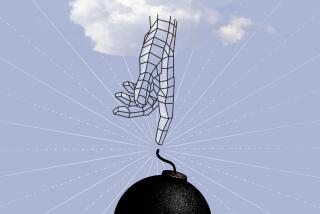Tale of Two Teds: Double Visions but Polar Opposites in Approach
- Share via
I have heard hypertext visionary Ted Nelson speak on three occasions, and each time was more disturbing than the last. His rant about how Apple Computer and Netscape Communications have perverted his vision of a universal hypertext library grows increasingly bitter and vitriolic. At the same time, his vision becomes ever more dated and irrelevant, as he continues to describe essentially the same set of ideas he came up with 20 years ago.
What’s so disturbing is that Nelson isn’t just some eccentric anomaly. He represents a breed that haunts Silicon Valley: brilliant technologists who fall in love with their own visions. More than a personal foible, it represents a complete misunderstanding of what technological innovation is all about.
To see the difference between having a vision and falling in love with one, you need to turn to another Ted: the brilliant and hyperkinetic Ted Selker.
Selker is a researcher at IBM’s Almaden Research Center and the developer of the TrackPoint III--the small, red pointing device used with ThinkPad laptops.
He had an epiphany a few years back, while thinking about the time computer users waste when they remove their hands from the keyboard in order to use the mouse. If the pointing device was located at the thumb position, Selker realized, that wasted time could be eliminated.
With this rough concept in mind, he began his search for a device that was small enough to fit between the keys in a keyboard but that could still be used to position as accurately as a mouse.
What he and his fellow researchers eventually came up with was a small, cup-shaped device that poked up from between the B and N keys.
“At that point, we thought we had the most wonderful pointing device in the world,” admits Ted Selker. Indeed, in rigorous user tests it proved to be faster and more accurate than a mouse or trackball for almost every application.
However, for his invention to leave the lab and enter the marketplace, Selker needed to convince the man who was in charge of user testing for IBM Japan. And Selker knew this wasn’t going to be easy: Not only was the Japanese engineer already personally invested in success of an alternate, trackball-like device, he also disliked the TrackPoint because it left a small, uncomfortable imprint in your fingertip.
Although Selker thought this objection was ridiculous--”Ferraris have stiff, uncomfortable suspensions too,” he reasoned--he realized he needed to negotiate.
This is the first and most obvious difference between Nelson and Selker. Selker understood that technological innovation is fundamentally a process of negotiation. Sociologists who study technology refer to the process as “heterogeneous engineering”--both the social and physical worlds must be engineered successfully.
“I knew that forgetting about my ego was the only way to succeed,” Selker recalls.
“Even though I was absolutely convinced that the TrackPoint was as close to perfect as possible, I had to somehow get him [the Japanese engineer] involved,”
The solution was a few intense weeks of collaboration between Selker and the testing engineer, and it resulted in a flat-topped, squishy-rubber device that was not only more comfortable but also more accurate. The collaboration also convinced the test engineer that the TrackPoint was the best candidate.
Yet even once the TrackPoint had been selected for use with IBM’s new notebook computer, Selker’s work was far from over. He remained intimately involved with every detail of his product--even down to writing the microcode for the device--despite pressure from others at IBM to stay in the lab and out of the factory.
This is the second, critical difference between the two Teds. Nelson seems to believe that innovation is a two-step process: brilliant idea and then development. Selker, however, knows that it is more like a 30-step process that begins with the brilliant idea, then the architectural design, then a quick demo, then testing on friends, and so on until you finally reach Step 30: warranty returns. And then it’s time for the next cycle! Furthermore, at each step, the developer needs to be ready to engage in a process of refinement, negotiation--and threats.
When the TrackPoint finally came out, it was an enormous success and helped differentiate IBM’s notebook from the slew of competing models. The TrackPoint has been widely heralded in the trade media, and today Selker is an IBM Fellow.
But for Ted, the process still isn’t over. When I spoke with him last week he was in the middle of fighting to integrate force feedback into the next version of the TrackPoint. This feature allows users to actually “feel” when the cursor runs over an icon or button and helps improve performance.
I started off this article by accusing Ted Nelson of falling in love with his own vision, but that by itself isn’t the problem. After all, Ted Selker is clearly obsessed with his idea as well.
But what Selker understands and Nelson doesn’t, is that when you really love something, you make sure it succeeds--no matter how much political machination and sweat it takes.






